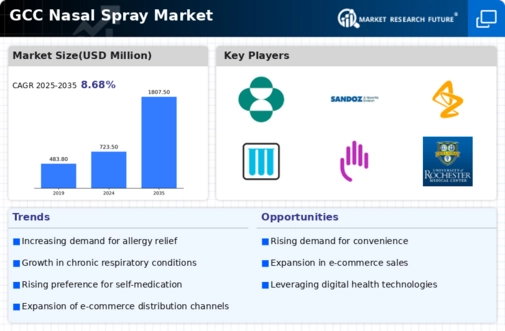Growth of Online Retail Platforms
The nasal spray market is benefiting from the rapid expansion of online retail platforms in the GCC region. E-commerce has transformed the way consumers access healthcare products, providing them with greater convenience and a wider selection of nasal sprays. This trend is particularly relevant in urban areas, where busy lifestyles make online shopping an attractive option. As more consumers turn to digital channels for their healthcare needs, the nasal spray market is likely to see increased sales through these platforms. The ability to compare products and read reviews online further empowers consumers, driving market growth.
Expansion of Pharmaceutical Innovations
The nasal spray market is witnessing a surge in pharmaceutical innovations, which are enhancing the efficacy and safety of these products. Recent advancements in formulation technologies have led to the development of novel nasal sprays that offer improved delivery mechanisms and reduced side effects. For instance, the introduction of preservative-free formulations is gaining traction among consumers concerned about potential irritants. This innovation is expected to drive market growth, as the nasal spray market adapts to evolving consumer needs and preferences. Furthermore, the GCC region is becoming a hub for research and development, fostering an environment conducive to such innovations.
Rising Awareness of Preventive Healthcare
The nasal spray market is experiencing growth due to increasing awareness of preventive healthcare measures among the GCC population. As individuals become more health-conscious, there is a growing emphasis on managing symptoms before they escalate into more serious conditions. Nasal sprays, particularly those designed for allergy relief and congestion, are being recognized as effective preventive tools. This shift in mindset is likely to bolster the nasal spray market, as consumers proactively seek out products that can enhance their quality of life and reduce the burden of respiratory ailments.
Increasing Prevalence of Respiratory Disorders
The nasal spray market is experiencing growth due to the rising incidence of respiratory disorders in the GCC region. Conditions such as allergic rhinitis and sinusitis are becoming more common, leading to a higher demand for effective treatment options. According to health statistics, approximately 30% of the population in GCC countries suffers from some form of allergy, which drives the need for nasal sprays. This trend is likely to continue as urbanization and environmental factors contribute to worsening air quality, exacerbating respiratory issues. Consequently, the nasal spray market is poised for expansion as healthcare providers increasingly recommend these products for symptom relief.
Consumer Preference for Non-Invasive Treatments
The nasal spray market is benefiting from a shift in consumer preferences towards non-invasive treatment options. Patients are increasingly seeking alternatives to oral medications and injections, favoring nasal sprays for their ease of use and rapid onset of action. This trend is particularly evident in the GCC, where healthcare systems are promoting patient-centric approaches. The convenience of nasal sprays, which can be self-administered without the need for medical supervision, enhances their appeal. As a result, the nasal spray market is likely to see sustained growth as more consumers opt for these user-friendly solutions.

















Leave a Comment